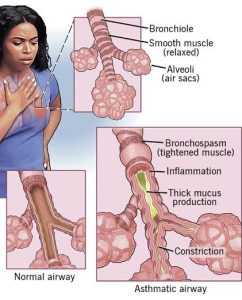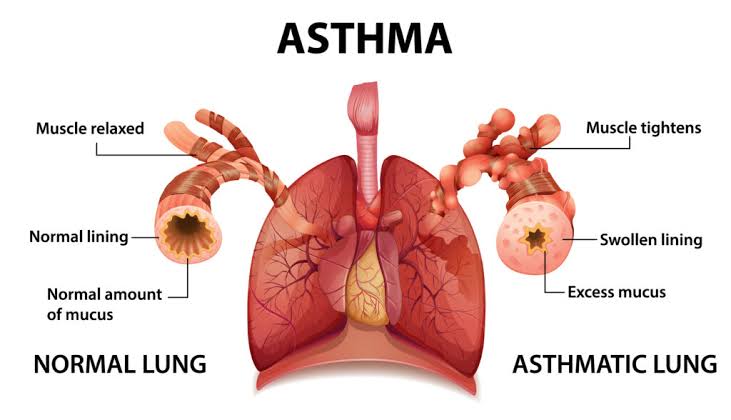As I lay in bed, gasping for air, I felt like my lungs were suffocating me. Asthma, my arch-nemesis, had me in its grip once again. But I refused to give up. I remembered the words of my doctor, “You are the Breathkeeper, the guardian of your own lungs.” With newfound determination, I embarked on a journey of medical discovery, seeking the latest treatments to tame the beast within me.
With each new treatment, I felt my lungs slowly awakening from their slumber. Inhalers and nebulizers became my trusted allies, delivering life-giving medication to my starving airways. I learned to listen to my body, to anticipate the warning signs of an attack, and to strike back with precision. And then, the breakthrough: a revolutionary new therapy that targeted the very root of my asthma. I felt my breath growing stronger, freer, with each passing day.
I am the Breathkeeper, and I have reclaimed my air! With every breath, I feel a sense of triumph, of hope, of possibility. I envision a future where I can run through fields, climb mountains, and dance in the rain, without fear of suffocation. The treatments have not only healed my lungs but have also awakened a sense of purpose within me. I will continue to guard my breath, to nurture it, and to push beyond the boundaries of what is possible. For I am the Breathkeeper, and I will not be silenced.
What is Asthma?

Asthma is a chronic respiratory disease characterized by inflammation, airway obstruction, and spasm of the bronchial tubes, which are the airways that lead to the lungs. It causes recurring episodes of wheezing, coughing, chest tightness, and shortness of breath.
Causes
1. Allergies: Dust mites, pollen, mold, pet dander, and cockroach droppings can trigger asthma attacks.
2. Respiratory Infections: Colds, flu, and other viral and bacterial infections can irritate the airways and trigger asthma.
3. Air Pollution: Exposure to smoke, fumes, and particulate matter can aggravate asthma.
4. Exercise: Physical activity can trigger asthma attacks, especially in cold and dry environments.
5. Stress: Emotional stress can trigger asthma attacks or make symptoms worse.
6. Genetics: Family history and genetic predisposition can increase the risk of developing asthma.
7. Occupational Exposures: Workplace exposures to chemicals, dust, and other substances can trigger asthma.
8. Tobacco Smoke: Secondhand smoke can trigger asthma attacks and make symptoms worse.
9. Hormonal Changes: Hormonal fluctuations during menstruation, pregnancy, or menopause can affect asthma.
10. Gastroesophageal Reflux Disease (GERD): Stomach acid reflux can trigger asthma attacks, especially at night.
Additionally, other factors that can contribute to asthma include:
– Obesity
– Premature birth
– Low birth weight
– Certain medications (such as aspirin and beta-blockers)
– Weather changes (cold air, humidity)
It’s essential to identify and manage individual triggers to control asthma symptoms effectively.
Types
1. Allergic Asthma: Triggered by allergies, such as dust mites, pollen, mold, pet dander, and cockroach droppings.
2. Non-Allergic Asthma: Triggered by factors other than allergies, such as respiratory infections, air pollution, exercise, and stress.
3. Exercise-Induced Bronchospasm (EIB):Triggered by physical activity, especially in cold and dry environments.
4. Occupational Asthma: Triggered by workplace exposures to chemicals, dust, and other substances.
5. Nocturnal Asthma: Symptoms worsen at night, often due to allergens, sinusitis, or gastroesophageal reflux disease (GERD).
6. Cough Variant Asthma: Characterized by a persistent, dry cough, often without wheezing or shortness of breath.
7. Mixed Asthma: Combination of allergic and non-allergic triggers.
8. Steroid-Resistant Asthma: Symptoms do not respond to corticosteroid medications.
9. Brittle Asthma: Severe, unpredictable asthma with sudden, frequent attacks.
10. Childhood Asthma: Asthma that develops in children, often triggered by allergies and respiratory infections.
Understanding the type of asthma helps tailor treatment plans and manage symptoms effectively.
Pathophysiology
1. Inflammation: Allergens, irritants, or other triggers activate immune cells, releasing inflammatory mediators (e.g., histamine, cytokines).
2. Airway Hyperresponsiveness: Inflammation leads to increased sensitivity and reactivity of airway smooth muscle, causing bronchospasm.
3. Mucus Production: Goblet cells and submucosal glands produce excess mucus, clogging airways.
4. Airway Remodeling: Chronic inflammation causes structural changes, such as thickening of airway walls, smooth muscle hypertrophy, and angiogenesis.
5. Bronchospasm: Airway smooth muscle contracts, narrowing airways and reducing airflow.
6. Airflow Obstruction: Inflammation, mucus, and bronchospasm combine to reduce airway diameter, increasing resistance to airflow.
7. Hypoxia: Reduced airflow leads to decreased oxygen levels in the blood, causing hypoxia.
Key players in asthma pathophysiology include:
– T-cells: Regulate immune responses
– Eosinophils: Contribute to inflammation and airway damage
– Mast cells: Release histamine and other mediators
– Airway smooth muscle: Contracts, causing bronchospasm
– Epithelial cells: Produce mucus and inflammatory mediators
Signs and Symptoms
Mild Symptoms:
1. Coughing: Dry or productive cough, often worse at night
2. Wheezing: High-pitched whistling sound while breathing out
3. Shortness of Breath: Feeling of not getting enough air
4. Chest Tightness: Feeling of constriction or tightness in the chest
Moderate Symptoms:
1. Increased Coughing: More frequent and severe coughing
2. Wheezing: Louder and more persistent wheezing
3. Breathlessness: Feeling of not getting enough air, even when sitting still
4. Chest Pain: Sharp or dull pain in the chest
Severe Symptoms:
1. Severe Wheezing: Very loud and persistent wheezing
2. Coughing Up Mucus: Thick, yellow or green mucus
3. Breathing Difficulty: Struggling to breathe, even when sitting still
4. Blue Lips or Fingers: Cyanosis, a sign of low oxygen levels
5. Confusion or Loss of Consciousness: In severe cases, asthma can lead to respiratory failure
Other Symptoms:
1. Fatigue: Feeling tired or exhausted
2. Anxiety or Panic: Feeling anxious or panicked due to breathing difficulties
3. Rapid Heartbeat: Increased heart rate due to stress or breathing difficulties
Asthma Attack:
A sudden worsening of symptoms, characterized by:
1. Sudden Onset: Rapid increase in symptoms
2. Severe Wheezing: Very loud and persistent wheezing
3. Breathing Difficulty: Struggling to breathe
4. Coughing Up Mucus: Thick, yellow or green mucus
If you experience any of these symptoms, seek medical attention.
Prevention
1. Avoiding Triggers: Identify and avoid allergens, irritants, and other triggers.
2. Medication Adherence: Take medications as prescribed, including controller medications and rescue inhalers.
3. Monitoring Symptoms: Track symptoms and adjust treatment plans accordingly.
4. Lifestyle Changes:
– Exercise regularly, but warm up slowly and use medication as needed.
– Maintain a healthy weight.
– Reduce stress through relaxation techniques.
– Get enough sleep.
– Avoid smoking and secondhand smoke.
5. Immunizations: Stay up-to-date on recommended vaccinations, including flu and pneumonia shots.
6. Allergy Management: If allergies trigger asthma, consider allergy shots or sublingual immunotherapy.
7. Breathing Exercises: Techniques like yoga, Pilates, or diaphragmatic breathing may help improve lung function.
8. Air Quality Control:
– Use HEPA filters.
– Remove carpets and rugs.
– Reduce pet exposure.
– Avoid strong chemicals and fragrances.
9. Regular Check-Ups: Schedule regular appointments with your healthcare provider to adjust treatment plans and monitor progress.
10. Asthma Action Plan: Develop a personalized plan with your healthcare provider to manage symptoms and respond to attacks.
By following these prevention strategies, you can reduce the frequency and severity of asthma attacks and improve overall lung health.
Treatment and Management
Medications:
1. Controller Medications: Taken daily to control symptoms and prevent attacks.
– Inhaled corticosteroids
– Long-acting beta agonists (LABAs)
– Combination inhalers
2. Rescue Medications: Used during attacks to relieve symptoms.
– Short-acting beta agonists (SABAs)
– Anticholinergics
3. Biologics: Targeted therapies for severe asthma.
– Omalizumab
– Mepolizumab
– Benralizumab
Lifestyle Changes:
1. Avoid Triggers: Identify and avoid allergens, irritants, and other triggers.
2. Exercise: Regular physical activity, but warm up slowly and use medication as needed.
3. Weight Management: Maintain a healthy weight.
4. Stress Reduction: Relaxation techniques like yoga, meditation, or deep breathing.
5. Sleep: Get enough sleep and establish a consistent sleep schedule.
Other Treatments:
1. Pulmonary Rehabilitation: Programs to improve lung function and overall health.
2. Allergy Shots: Immunotherapy for allergen-specific asthma.
3. Bronchial Thermoplasty: Procedure to reduce airway constriction.
Asthma Action Plan:
1. Develop a Plan: Work with your healthcare provider to create a personalized plan.
2. Monitor Symptoms: Track symptoms and adjust treatment accordingly.
3. Respond to Attacks: Follow the plan’s instructions during asthma attacks.
By combining medications, lifestyle changes, and avoiding triggers, you can effectively manage asthma and improve your quality of life.

